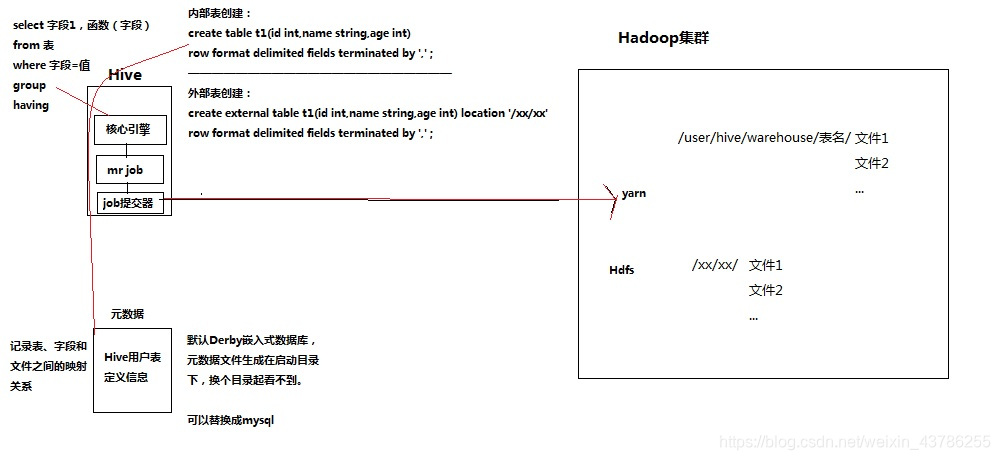一、Hive是什么
Hive是基于Hadoop的一个数据仓库工具(离线),可以将结构化的数据文件映射为一张数据库表,并提供类SQL查询功能。,它能接收用户输入的sql语句,然后把它翻译成mapreduce程序对HDFS上的数据进行查询、运算,并返回结果,或将结果存入HDFS。
要点:HIVE利用HDFS来存储数据文件;利用MAPREDUCE来做数据分析运算;利用SQL来为用户提供查询接口;
二、Hive的安装及配置
1.1.用内嵌derby作为元数据库
(1)安装hive的机器上应该有HADOOP环境(安装目录,HADOOP_HOME环境变量);(2)直接解压一个hive安装包即可此时,安装的这个hive实例使用其内嵌的derby数据库作为记录元数据的数据库此模式不便于使用。
1.2.将mysql作为元数据库
以lunix安装为例:(1)上传mysql安装包;(2)解压;(3)安装mysql的server包;(4)安装mysql的客户端r包;(5)启动mysql的服务;(6)修改初始密码;(7)测试。注意点:要让mysql可以远程登录访问
2.修改hive的配置文件
修改hive-site.xml配置文件:
| <configuration> <property> <name>javax.jdo.option.ConnectionURL</name> <value>jdbc:mysql://master:3306/hive?createDatabaseIfNotExist=true</value> </property>
<property> <name>javax.jdo.option.ConnectionDriverName</name> <value>com.mysql.jdbc.Driver</value> </property>
<property> <name>javax.jdo.option.ConnectionUserName</name> <value>root</value> </property>
<property> <name>javax.jdo.option.ConnectionPassword</name> <value>123456</value> </property> </configuration> |
3.上传一个mysql的驱动jar包到hive的安装目录的lib中
4.配置HIVE_HOME到系统环境变量中:/etc/profile
5.source /etc/profile
6.hive启动
三、启动Hive的三种方式
1.启动一个hive交互式查询shell
bin/hive
hive>
2.启动hive的网络服务,然后通过一个客户端beeline去连接服务进行查询
启动服务: bin/hiveserver2
启动客户端去连接hive服务: bin/beeline -u jdbc:hive2://slave2:10000 -n root
3.启动hive以一个脚本的方式
当有大量的hive查询任务时使用脚本化运行机制效率较高,该机制的核心点是:hive可以用一次性命令的方式来执行给定的hql语句。示例如下:
vi t_t.sh
| #!/bin/bash hive -e "insert into table t_max select id,max(age) from t_1 group by gender'" hive -e 'create table t_sum as select id,sum(amount) from t_1 group by id' |
四、Hive建库建表与数据导入(DDL)
1、建库:create database hello; 库目录:/user/hive/warehouse/hello.db
hive中有一个默认的库:库名: default 库目录:/user/hive/warehouse
2、建表:
内部表:表目录按照hive的规范来部署,位于hive的仓库目录/user/hive/warehouse中
create table t1(id int,name string,age int)
row format delimited fields terminated by ',';
外部表:表目录由建表用户自己指定
create external table t2(id int,name string,age int)
row format delimited fields terminated by ','
location ‘/xx/xx/’;
注意:drop内部表时,表目录会被删除,表的元数据也会被删除
drop外部表时,是表目录还在,但表的元数据会被删除
3、删除表
drop table t1;
4、导入数据到表中
实际上,只要把数据文件放入表目录即可 hadoop fs -put ......
hive命令:
如果文件在hive的本地磁盘: load data local inpath ‘/home/t_t.dat’ into table t1;
如果文件在hdfs上:load data inpath ‘/t_t.dat’ into table t1;
提醒:hive不会对用户所导入的数据做任何的检查和约束
5、修改表的定义
修改表名:alter table table_name rename to new_table_name
alter table t1 rename to t2;
修改字段名、字段类型:alter table table_name change [column] col_old_name col_new_name column_type [commentcol_comment] [first|(after column_name)]
alter table t1 change id oid float first;
增加、替换列:alter table table_name add|replace columns (col_name data_type[comment col_comment], ...)
alter table t1 add columns (gender string,phone int);
alter table t1 replace columns (id int,age int,name string);
6、分区表
在表目录中为数据文件创建分区子目录,以便于在查询时,mr程序可以针对指定的分区子目录中的数据进行处理,减少读取的范围,提高效率。
内部表分区建表:
| create table t1(id int,uid string,price float,amount int) partitioned by (day string,city string) row format delimited fields terminated by ','; |
已存在的文件夹作为表的一个分区,映射到表的分区:
| alter table t2_ex add partition(day=’2018-11-25’) local ‘/2018-11-25’; |
注意:分区字段不能是表定义中的已存在字段
导入数据到指定分区:
| load data [local] inpath '/home/t_t.txt' into table t2 partiton(day='2018-11-25',city='shengzheng'); |
根据分区进行查询:
| select count(*) from t2 where day='20170804' and city='shengzheng'; 将分区字段当成表字段来用,就可以使用where子句指定分区了 |
7、根据已存在的表建表
1、create table t_t2 like t _t1; 新建的 t_t2表结构定义与源表 t_t1一致,但是没有数据
2、create table t_t2 as select id,name from t_t1; 根据select查询的字段来建表,将查询的结果插入新表中
8、将表中的数据导出到指定路径的文件
| insert overwrite [local] directory '......' row format delimited fields terminated by ',' select * from t1; |
加local代表导入到本地磁盘文件,没加则代表导入到hdfs
五、SQL语法
sql运算模型一:逐行运算模型(逐行表达式,逐行过滤) 例:select id,upper(name),age from t1;
sql运算模型二:分组运算模型(分组表达式,分组过滤)
例:select id,avg(money) from t1 where money >=1000 group by gender having avg(age) <= 23;
sql的join联表机制:join的实质是将多个表的数据连成一个表,作为查询的输入数据集,hive不支持不等值join
笛卡尔积连接 例:select a.*,b.* from a join b;
内连接 例:select a.*,b.* from a join b on a.id = b.id;
左外连接:左表的数据全返回作为查询的输入数据集 例:select a.*,b.* from a left join b on a.id = b.id;
右外连接:右表的数据全返回作为查询的输入数据集 例:select a.*,b.* from a right join b on a.id = b.id;
全外连接:两表的数据全返回作为查询的输入数据集 例:select a.*,b.* from a full join b on a.id = b.id;
左半连接:hive特有,按照内连接的规律链接,但只返回左半部分作为查询的输入集
对select a.* from a where id in (select distinct id from b);
例:select id,name from a left semi join b on a.id = b.id;
子查询:本质就是将一个select查询的结果集作为下一个查询的输入数据集
| select a.city,a,city_sum from (select city,sum(price*amount) as city_sum from t1 group by city) a where a.city_sum>300; |
order by 排序:order by 永远写在一个select语句的最后,limit前; limit n :限制select返回的结果条数;
| select city,sum(price*amount) as city_sum from t1 group by city order by city_sum asc limit 2; |
in 过滤条件子句: select a.* from a where id in (select distinct id from b);
distinct 去重关键字:distinct的前面不能再有表达式;distinct后面的表达式会被看成组合去重
六、数据类型
1、数字类型
tinyint(1字节整数);smallint(2字节整数);int/integer (4字节整数);bigint(8字节整数);float(4字节浮点数);double (8字节双精度浮点数)
2、字符串类型
string;varchar(20) (字符串1-65535长度,超长截断);char (字符串,最大长度255)
3、BOOLEAN(布尔类型)
trune;false
4、时间类型
timestamp(时间戳) (包含年月日时分秒毫秒的一种封装);date (日期)(只包含年月日)
5、array数组类型
array<data_type>
6、map类型
map<primitive_type, data_type>
7、struct类型
struct<col_name : data_type, ...>
用一个字段来描述整个用户信息,可以采用struct
七、常用内置函数
1、类型转换函数
| select cast("10" as int) select cast("2018-11-25" as date) ; select cast(current_timestamp as date); |
2、数学运算函数
| select round(2.5); ## 3 四舍五入 select round(2.2315,3) ; ##2.231 select ceil(2.2) ; // select ceiling(2.2) ; ## 3 向上取整 select floor(2.2); ## 2 向下取整 select abs(-2.2) ; ## 2.2 绝对值 select greatest(id1,id2,id3) ; ## 单行函数,多个输入参数中的最大值 select least(2,3,7) ; ##单行函数,求多个输入参数中的最小值 |
3、字符串函数
| upper(string str) ##转大写 lower(string str) ##转小写 substr(string str, int start) ## 截取子串 substring(string str, int start) substr(string, int start, int len) substring(string, int start, int len) concat(string A, string B...) ## 拼接字符串 concat_ws(string SEP, string A, string B...) length(string A) split(string str, string pat) ## 切分字符串,返回数组 注意:select split("192.168.33.44",".") ; 错误的,因为.号是正则语法中的特定字符 select split("192.168.33.44","\\.") ;
|
4.时间函数
| select current_timestamp; ## 返回值类型:timestamp,获取当前的时间戳(详细时间信息) select current_date; ## 返回值类型:date,获取当前的日期 unix时间戳转字符串格式——from_unixtime from_unixtime(bigint unixtime[, string format]) 示例:select from_unixtime(unix_timestamp()); select from_unixtime(unix_timestamp(),"yyyy/MM/dd HH:mm:ss"); 字符串格式转unix时间戳——unix_timestamp:返回值是一个长整数类型 如果不带参数,取当前时间的秒数时间戳long--(距离格林威治时间1970-1-1 0:0:0秒的差距) select unix_timestamp(); unix_timestamp(string date, string pattern) 示例: select unix_timestamp("2018-11-25 10:00:00"); select unix_timestamp("2018-08-10 10:00:00","yyyy-MM-dd HH:mm:ss"); 将字符串转成日期date select to_date("2018-11-25 10:00::00"); |
5、条件控制函数
if select id,if(age>18,'male','children') from t1;
case when
case
when condition1 then result1
when condition2 then result2
...
when conditionn then resultn
end
6、聚合函数
| array(5,4,6,1) 构造一个整数数组 array(‘hello’,’hi’,’nihao’) 构造一个字符串数组 array_contains(Array<T>, value) 判断是否包含,返回boolean值 sort_array(Array<T>) 返回排序后的数组 size(Array<T>) 返回一个集合的长度,int值 size(Map<K.V>) 返回一个imap的元素个数,int值 size(array<T>) 返回一个数组的长度,int值 map_keys(Map<K.V>) 返回一个map字段的所有key,结果类型为:数组 map_values(Map<K.V>) 返回一个map字段的所有value,结果类型为:数组 |
7、常见分组聚合函数
| sum(字段) : 求这个字段在一个组中的所有值的和 avg(字段) : 求这个字段在一个组中的所有值的平均值 max(字段) :求这个字段在一个组中的所有值的最大值 min(字段) :求这个字段在一个组中的所有值的最小值 |
)


)




)










)